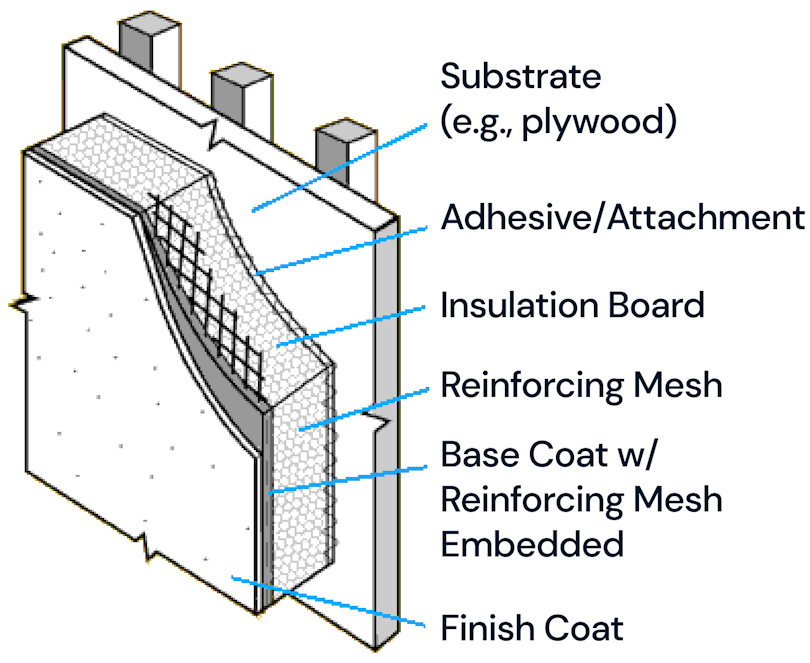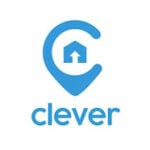Should you buy a home with EIFS? | EIFS vs. traditional stucco | Pros | Cons | Repair costs | FAQs
When properly installed, exterior insulation finishing systems (EIFS) are considered more durable and energy-efficient than traditional stucco.
EIFS is a synthetic type of stucco with built-in insulation. It was developed in the 1970s as a more affordable way to control a building's temperature.
When improperly installed, EIFS can be expensive to repair and can even threaten your health. Due to widespread bad installations during the '70s and '80s, EIFS has a less-than-stellar reputation in the U.S.
Should you buy a home with EIFS?
Whether or not you should buy a home with EIFS depends on a few factors:
- When was the home built?
- Does it already have damage?
- What is the climate like where the house is located?
If the home you want was built after 1999 and passes inspection, it's an easy YES! After 1999, EIFS installation standards greatly improved, so there's not much to worry about with these newer builds.
If the home you're buying is older than 1999, you should hire an EIFS-certified inspector. They will be the most qualified to let you know if the home is in good condition. You can also request a warranty from the owner for more peace of mind.
If the inspection does find damage related to EIFS, you have some options:
- Ask the seller to cover the repairs
- Negotiate a lower purchase price so that you can pay for repairs yourself
- Walk away from the deal
» LEARN: How much does a specialized home inspection cost?
EIFS is better suited to more arid climates and desert regions. If you live in a rainy area, EIFS probably isn't the best choice for you as it can be prone to water damage.
| ✅ Well-installed EIFS can mean... | ❌ Poorly installed EIFS can lead to... |
|---|---|
| Energy efficiency | Mold |
| Durability (impact, moisture, and fire) | Damage to frame and exterior |
| Design versatility | Pest infestations |
| Material efficiency | Expensive repairs |
| Read more » | Read more » |
How do I find out the quality of a home with EIFS?
Hiring an inspector with EIFS certification is a must for older homes.
If a home with EIFS was built between 1970 and 1999, that can be a red flag. EIFS was still new to the U.S. then, and bad installations were common.
EIFS installed after 1999 adhered to higher standards and is generally considered safe.
What's the difference between EIFS and traditional stucco?
| EIFS | Stucco |
|---|---|
| Offers more energy efficiency | Made of natural materials |
| Made of synthetic materials | Layered over insulation |
| Built-in insulation bound to siding | Cheaper to repair or replace |
| Expensive to repair or replace | Easier to replace than repair |
| Easy to repair |
These days, EIFS and stucco are equally common and hard to tell apart just by looking at a home's exterior.
What is EIFS?
An exterior insulation finishing system (EIFS) is a type of exterior siding made of insulation and synthetic materials. It's also sometimes called "synthetic stucco."
Unlike traditional stucco, EIFS has several layers. Notably, it binds a layer of insulation to the siding itself, protecting the insulation — as well as the framing, plumbing, electrical, and foundation — from water damage.

✍Other names for EIFS
|
Clever can help you find your dream home — and keep more money in your pocket too! With Clever, you'll: ✅ Buy with a top agent from major brokerages like RE/MAX and Century 21 ✅ Get real-time MLS updates ✅ Earn cash back on qualifying purchases Clever's service is 100% free, with zero obligation. You can interview as many agents as you like, or walk away at any time. Enter your zip code to find a top local agent today!
What is traditional stucco?
Traditional stucco is a type of exterior siding made out of cement, lime, sand, and water. Given that it uses natural materials, it's cheaper to install than EIFS.
Unlike EIFS, traditional stucco is applied OVER insulation. There are two varieties: one-coat (which is cheaper) and three-coat (which is more durable).
Advantages of EIFS
The biggest advantage of EIFS is its high energy efficiency, especially in warmer climates.
EIFS stucco is also more materially efficient, thanks to its 3-in-1 advantage: insulation, exterior, and design of the exterior.
Another advantage to EIFS is its durability. You can expect:
- Impact resistance
- Fire resistance
- Waterproofing
| 💧 While it has a bad reputation for being prone to water damage, that's due to bad installations that left out a moisture barrier. When properly installed, EIFS's waterproofing substrate is superior to traditional stucco when it comes to moisture control in your home. |
Because its top layer is malleable and versatile, EIFS is easier to patch and repaint — or replace altogether — should you need any repairs down the line. And since it's so cost-effective, EIFS is becoming more common, especially in warmer climates, so reputable contractors are easier to find.
Problems with EIFS
Poorly installed EIFS typically leads to water damage, which can cause a host of problems for homeowners:
- Wood damage
- Pest infestation
- Mold growth
The major problem areas for damage are anywhere where water can pool:
- Joints (like windows or door frames)
- Horizontal surfaces (like flat roofs or porches)
Including a drainage system within the EIFS can prevent moisture accumulation on the off chance water does get inside the siding.
Poor installation is the biggest risk with EIFS, though that's not an issue with the material itself. Before buying a house with EIFS, get it inspected by a certified professional to find any potential damage.
| ✍ Editor's note In rare cases, some home insurers won't underwrite a home with EIFS given its reputation. While this isn't a widespread policy, insurers tend to be vague about their EIFS policies, and it may be difficult to get answers beforehand. |
EIFS repair costs
EIFS typically costs $30–50 per square foot to replace — more expensive than $8–20 for stucco.
But it's relatively easy to repair since it can be removed and replaced in sections.
Plus, you'd usually only need to repair damaged sections, rather than the entire home's exterior.
Water damage repairs are the most expensive, as they may call for a complete replacement of the EIFS — and that can cost around $3,000.
Why leave extra money on the table? Clever can connect you with one of the top real estate agents in your area, plus put cash back in your pocket. With Clever: ✅ You'll work with a full-service realtor from a top broker ✅ You'll earn cash back on qualifying purchases ✅ It's free, with zero obligation — you can walk away at any time Fill out the form below to get started!
Frequently asked questions about EIFS stucco
What is EIFS?
Exterior insulating finishing system (EIFS) stucco is a type of exterior siding with built-in insulation made up of synthetic materials like plastic and mineral wool.
Is EIFS still used today?
Despite a polarizing reputation, EIFS is a commonly used type of exterior siding for both residential and commercial buildings today. While you're not able to tell if a home has EIFS from the outside, certified inspectors will be able to let you know.
What are the problems with EIFS?
When it hasn't been properly installed, EIFS could deal with water damage, which can then lead to other problems such as structural issues, mold, and pest infestation.
What's better, stucco or EIFS?
Both EIFS and traditional stucco are great options for exterior siding. Stucco is cheaper to install, but many builders find EIFS to be more durable and energy-efficient when properly installed. Traditional stucco is also cheaper to repair.
Should I remove EIFS?
Unless the EIFS exterior on your home is damaged, there's no reason to remove it. Removing EIFS can cost around $3,000, depending on the size of your home.
How do I get rid of EIFS?
EIFS can be removed piece by piece with readily available tools once the topcoat is removed.
Authors & Editorial History
Our experts continually research, evaluate, and monitor real estate companies and industry trends. We update our articles when new information becomes available.
-
April 11, 2024Written by
-
March 9, 2023Written by
